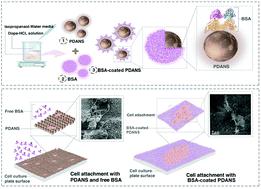Our official English website, www.x-mol.net, welcomes your feedback! (Note: you will need to create a separate account there.)
Polydopamine nanospheres coated with bovine serum albumin permit enhanced cell differentiation: fundamental mechanism and practical application for protein coating formation
Nanoscale ( IF 6.7 ) Pub Date : 2021-11-22 , DOI: 10.1039/d1nr07469e Behafarid Ghalandari 1 , Youyi Yu 1 , Farnaz Ghorbani 2 , Antony R Warden 1 , Khan Zara Ahmad 1 , Xiao Sang 1 , Shiyi Huang 1 , Yu Zhang 1 , Wenqiong Su 1 , Adeleh Divsalar 3 , Xianting Ding 1
Nanoscale ( IF 6.7 ) Pub Date : 2021-11-22 , DOI: 10.1039/d1nr07469e Behafarid Ghalandari 1 , Youyi Yu 1 , Farnaz Ghorbani 2 , Antony R Warden 1 , Khan Zara Ahmad 1 , Xiao Sang 1 , Shiyi Huang 1 , Yu Zhang 1 , Wenqiong Su 1 , Adeleh Divsalar 3 , Xianting Ding 1
Affiliation

|
Protein coating is a strategy for modifying and improving the surface functional properties of nanomaterials. However, the underlying mechanism behind protein coating formation, which is essential for its practical applications, remains largely unknown. Herein, we investigate the fundamental molecular mechanism of protein coating formation. Polydopamine nanospheres (PDANS) coated with bovine serum albumin (BSA) are examined in this study due to their wide biomedical potential. Our results demonstrate that BSAs can flexibly bind to PDANS and maintain their structural dynamicity. Our findings unveil that regular structure formation arises from BSAs lateral interactions via electrostatic forces. Notably, the protein coating modified PDANS surface enhances cell adhesion and proliferation as well as osteogenic differentiation. Such an enhancement is attributed to complementary surface properties provided by the dynamic PDANS–BSA complex and regular structure caused by BSA–BSA interactions in protein coating formation. This study provides a fundamental understanding of the molecular mechanism of protein coating formation, which facilitates the further development of functional protein-coated nanomaterials and guides the bioengineering decision making for biomedical applications, especially in bone tissue engineering.
中文翻译:

涂有牛血清白蛋白的聚多巴胺纳米球可增强细胞分化:蛋白质涂层形成的基本机制和实际应用
蛋白质涂层是一种修饰和改善纳米材料表面功能特性的策略。然而,对其实际应用至关重要的蛋白质涂层形成背后的潜在机制仍然很大程度上未知。在此,我们研究了蛋白质涂层形成的基本分子机制。由于其广泛的生物医学潜力,本研究检查了涂有牛血清白蛋白 (BSA) 的聚多巴胺纳米球 (PDANS)。我们的结果表明 BSA 可以灵活地绑定到 PDANS 并保持其结构动态。我们的研究结果揭示,经常结构形成从外侧的BSA相互作用产生经由静电力。值得注意的是,蛋白质涂层修饰的 PDANS 表面增强了细胞粘附和增殖以及成骨分化。这种增强归因于动态 PDANS-BSA 复合物和规则结构提供的互补表面特性,这是由蛋白质涂层形成中 BSA-BSA 相互作用引起的。该研究提供了对蛋白质涂层形成分子机制的基本理解,有助于进一步开发功能性蛋白质涂层纳米材料,并指导生物医学应用的生物工程决策,特别是在骨组织工程中。
更新日期:2021-11-30
中文翻译:

涂有牛血清白蛋白的聚多巴胺纳米球可增强细胞分化:蛋白质涂层形成的基本机制和实际应用
蛋白质涂层是一种修饰和改善纳米材料表面功能特性的策略。然而,对其实际应用至关重要的蛋白质涂层形成背后的潜在机制仍然很大程度上未知。在此,我们研究了蛋白质涂层形成的基本分子机制。由于其广泛的生物医学潜力,本研究检查了涂有牛血清白蛋白 (BSA) 的聚多巴胺纳米球 (PDANS)。我们的结果表明 BSA 可以灵活地绑定到 PDANS 并保持其结构动态。我们的研究结果揭示,经常结构形成从外侧的BSA相互作用产生经由静电力。值得注意的是,蛋白质涂层修饰的 PDANS 表面增强了细胞粘附和增殖以及成骨分化。这种增强归因于动态 PDANS-BSA 复合物和规则结构提供的互补表面特性,这是由蛋白质涂层形成中 BSA-BSA 相互作用引起的。该研究提供了对蛋白质涂层形成分子机制的基本理解,有助于进一步开发功能性蛋白质涂层纳米材料,并指导生物医学应用的生物工程决策,特别是在骨组织工程中。



























 京公网安备 11010802027423号
京公网安备 11010802027423号